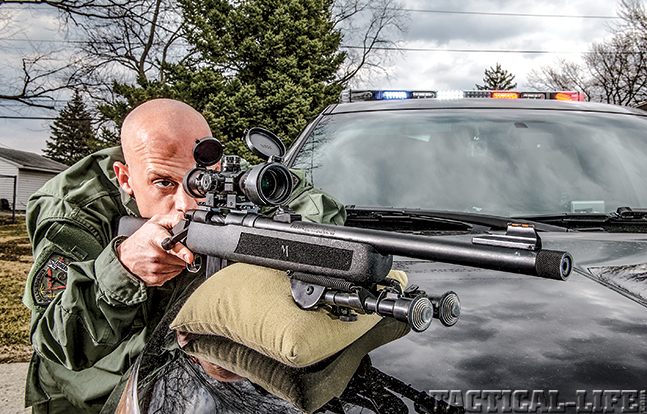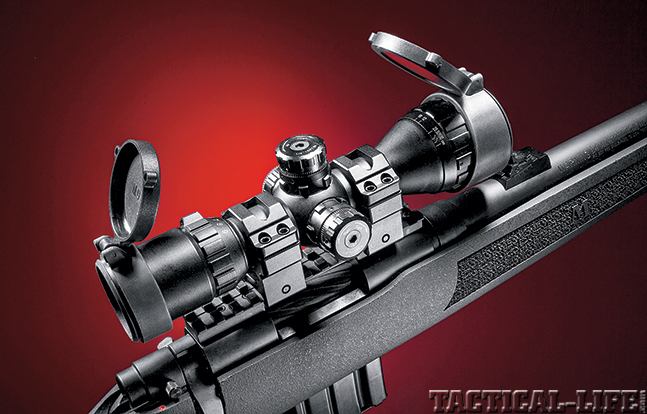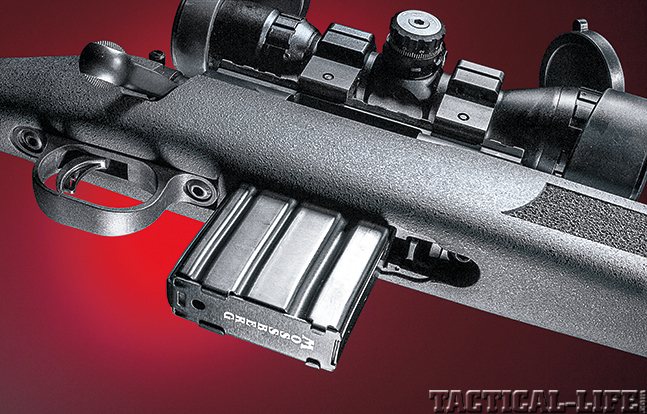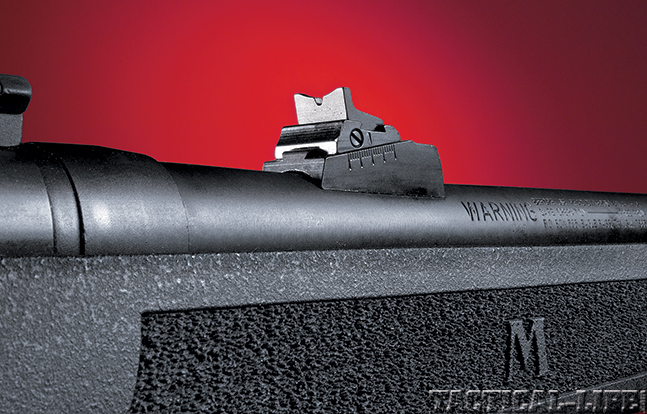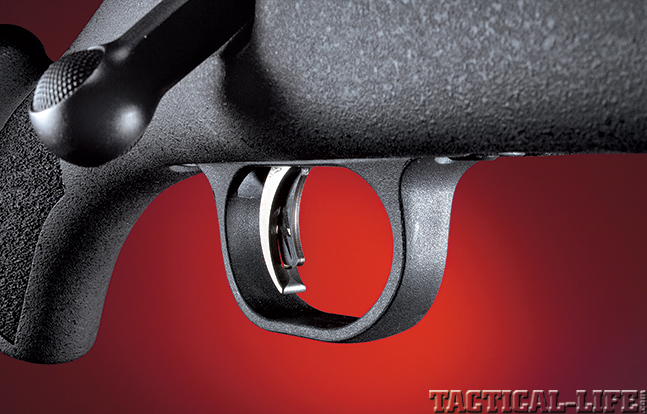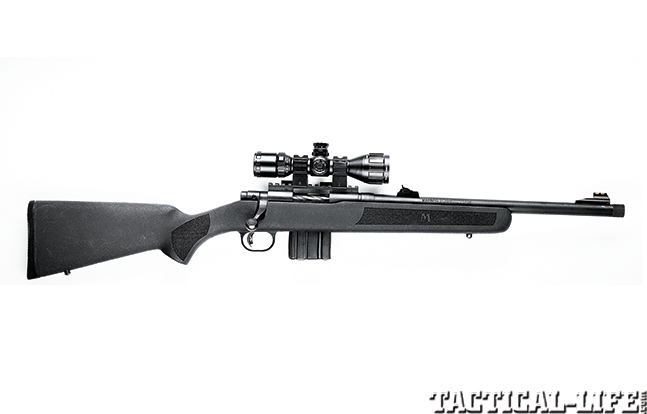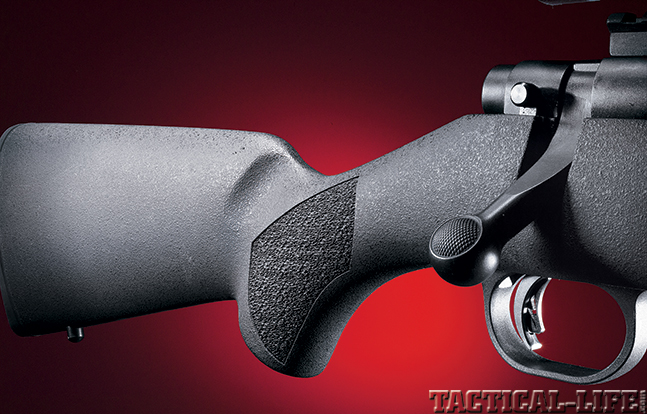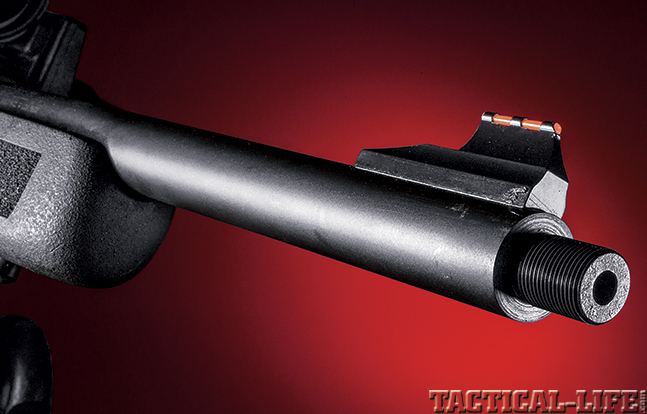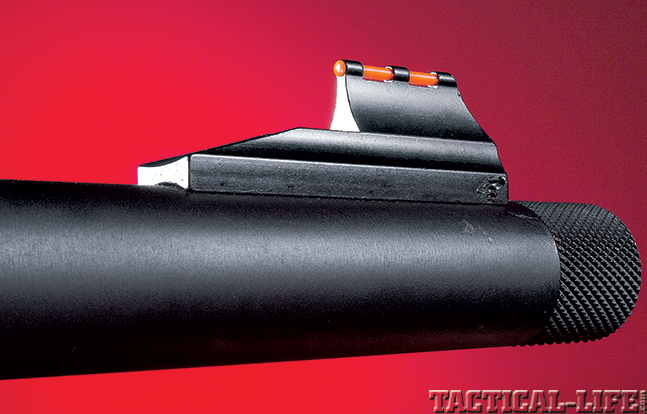The Mossberg MVP Patrol is often overlooked when tactical rifles are discussed. The MVP Patrol is the center of Mossberg’s law enforcement series. It is available from the factory in various calibers with many notable features, including different stock types, optional 3-9×32 riflescope, a Picatinny rail on top of the receiver and Mossberg’s industry-leading Lightning Bolt Action (LBA) adjustable trigger. Another thing that sets the MVP Patrol apart functionally and aesthetically is its ability to accept AR-15-type magazines. Prejudices abound when it comes to Mossberg rifles, usually stemming from misconceptions based on price and elitist sentiments. Many individuals, not to mention industry competitors, want you to believe that the moderately priced Mossberg must somehow be deficient when compared to rifles costing two to three times more. I want to point out that an individual or department’s needs should be fully analyzed and the Mossberg MVP Patrol considered. The Mossberg MVP Patrol takes a backseat to no rifle in terms of precision, ergonomics, reliability, capacity and safety.
Gun Details
My test MVP Patrol came chambered in 5.56mm NATO, and Mossberg also offers the rifle in 7.62mm NATO and 300 Blackout. The 5.56mm MVP Patrol has an overall length of 36 inches with a free-floating, medium-profile, 16.25-inch barrel capped with a threaded-on birdcage flash suppressor. The 1-in-9-inch-twist, button-rifled barrel gets the most out of the various wide-ranging 5.56mm loads on the market, from 50 to 77 grains. The MVP Patrol weighs 7 pounds unloaded without a scope attached. The rifle’s light weight, combined with its short barrel, gives it improved portability and above-average handling characteristics for a bolt-action rifle. Many tactical rifles, while accurate, resemble boat anchors when it comes to handling due to their weight and stock configuration.
Advertisement — Continue Reading Below
The basis of the MVP patrol is Mossberg’s modified 4×4 bolt action, which is machined from bar stock. The modification is a hinged tab on the bottom of the bolt head. This enables the use of AR-15 magazines. The tab slips between the narrow AR magazine feed lips and pushes cartridges into the chamber. Mossberg’s intention is for all AR magazine types to work with the MVP Patrol. I used different magazines during my testing—polymer, 30-round Magpul PMags, metal, 20-round Brownells magazines and the 10-round magazine Mossberg provides with the MVP Patrol—and did not experience any feeding issues with any of them. It’s also important to note that you can still feed single rounds if needed by simply laying them in the raceway.
“The MVP Patrol performed as well or better than other rifles I’ve tested in this format that cost significantly more.”
A polymer bedding block with an integral magazine well holds the barreled action. The bedding block fits inside the stock and is held in place by two steel pillars, through which the front and rear action screws pass.
Advertisement — Continue Reading Below
The MVP Patrol’s stock is rock solid, with design characteristics making it conducive to accurate shooting from a variety of positions. The wider-than-normal forend handles bipods or sandbags with equal aplomb. However, the MVP Patrol is not exclusively designed for shooting from supported prone or bench positions. The stock allows for off-hand and other types of supported fire if needed, such as rested on the hood or trunk of a squad car or other field-expedient positions. The stock’s ergonomics allow for a comfortable, repeatable cheekweld and grip, making it easier to pull the Mossberg LBA trigger smoothly.
The LBA trigger is a huge part of the MVP Patrol’s phenomenal accuracy-to-cost ratio. In my opinion, the LBA trigger is just as important to the Mossberg’s accuracy as its bolt action and quality barrel. A rifle’s trigger is the interface between the shooter and rifle, and it must be right or accuracy will suffer. So, Mossberg here has given the shooter an enhanced trigger that is crisp, creep-free and fully adjustable between 2 and 7 pounds. From the box, my test rifle’s trigger pull weight measured just below 4 pounds. Without going into minutia, the LBA’s distinctive “trigger blade” release lever in front of the trigger proper is the secret to maintaining minimal trigger weight, without creep, while keeping the system safe. The trigger blade must be activated (i.e., intentionally pulling the trigger) before the sear will move, firing the cartridge. A sudden drop or impact will not result in a discharge, even if the safety is off. This allows the LBA trigger to be adjusted by the user without having to resort to an armorer. The LBA’s contribution to precision cannot be overemphasized.
Range Time
Advertisement — Continue Reading Below
The first requirement of a tactical rifle is accuracy. To test the MVP Patrol, I mounted a Leupold 3.5-10x40mm Mark 4 scope on the one-piece Picatinny rail. At the range, I supported the MVP with a Champion tripod front rest and sandbags during the bench-testing phase of the evaluation. The Mossberg MVP Patrol constantly produced 1-MOA or better groups with several different ammunition brands—an important logistical consideration. Many will scoff at this as typical gun writer fluff—I would, too, if I had not been the one doing the shooting. It happened, and it’s a major reason why I am so enthusiastic about the Mossberg MVP Patrol.
Obviously, I picked the best ammunition brands and loads. I did not feel the need to cast my net wider, since Black Hills, Federal and Hornady are industry leaders, which is what this type of rifle deserves to wring out its full potential. The accuracy figures are based on firing three 5-round groups. While not statistically foolproof, my method certainly well represents the MVP Patrol’s capabilities. The Federal 69-grain Gold Medal Match and Black Hills 77-grain Match loads produced the best 100-yard averages at 0.75 inches. Hornady’s 55-grain and 75-grain TAP loads averaged an inch 100 yards. Again, no premium loads were over 1 MOA.
“The Mossberg MVP Patrol takes a backseat to no rifle in terms of precision, ergonomics, reliability, capacity and safety.”
Advertisement — Continue Reading Below
Another sign of an accurate, dependable rifle is how cold-bore zeros compare over time and if the point of aim shifts after a few rounds heat up the barrel. The Mossberg MVP Patrol showed no shifts in point of aim, and cold-bore zeros produced fine groups when overlaid together. My RCBS AmmoMaster chronograph showed velocity readings in the 2,700- to 2,800-fps range from the MVP Patrol’s 16.25-inch barrel.
I did extend the baseline accuracy testing with the Mossberg MVP Patrol out to 300 yards, even though this is an unlikely law enforcement scenario. I find 300 yards the more indicative test of a weapon system. More importantly, this generates useful ballistic information for the shooter, especially when it comes to elevation and windage data for logbooks and ballistic calculations. Significantly, all of the loads held onto the 1-MOA (approximately 3 inches at 300 yards) or better criteria. The heavier-weight 5.56mm bullets give up little ballistically to 7.62mm/.308 loads in terms of ballistic coefficients and trajectory. Obviously, terminal punch is more significant with a 168-grain or 175-grain 7.62mm cartridge compared to a 5.56mm.
The combination of the world-class Leupold scope, the smooth 4×4 bolt action and the great trigger generated performance better than what I’ve experienced from testing many other rifles. One of my favorite non-scientific evaluations is shooting at quarter-scale TacStrike steel targets scattered at various distances along the Echo Valley Training Center’s multi-stepped 350-yard range. I find this provides more feedback as to how a rifle performs in terms of bolt manipulation and how the stock interacts with the shooter during recoil as compared to firing off the bench at 100 yards. In this situation, the MVP performed very well.
Advertisement — Continue Reading Below
Final Notes
Many will wonder about the purpose or niche of the Mossberg MVP Patrol. Why not just use a tuned semi-automatic AR in lieu of the bolt-action MVP Patrol? The answer lies with an individual or department’s preferences for a bolt action. This could be based on cost, public perceptions or a myriad of other reasons.
The MVP Patrol’s 5.56mm chambering is more than adequate for the bulk of law enforcement duties, including precision interdiction, especially considering the minimal distances that law enforcement countersniping often takes place within. The MVP Patrol’s threaded muzzle makes it easier to mount a sound suppressor, further enhancing its flexibility for law enforcement use. Even though it’s a bolt action, the MVP Patrol should not be pigeonholed into solely a sniper rifle role. There a many jurisdictions that will appreciate its non-assault-rifle persona while maintaining its high capacity—think lightweight patrol rifle with a 30-round capacity. The use of detachable AR magazines simplifies loading/unloading procedures compared to fixed box magazines that require the action to be manipulated to unload.
Advertisement — Continue Reading Below
While not fair to compare the Mossberg MVP Patrol to other rifles costing thousands more, it is unavoidable. The MVP Patrol performed as well or better than other rifles I’ve tested in this format that cost significantly more. I urge readers, whether civilian or LE, not to fall into the trap of thinking that dollars equate to proficiency. Yes, equipment is a huge part of the skills equation when it comes to precision marksmanship, but it is often emphasized in lieu of training and practice. The Mossberg MVP Patrol is not a compromise candidate in terms of performance, though a user will benefit from selecting it by having funds left in the budget for optics, ammunition and training.
For more information, visit mossberg.com or call 800-363-3555.
